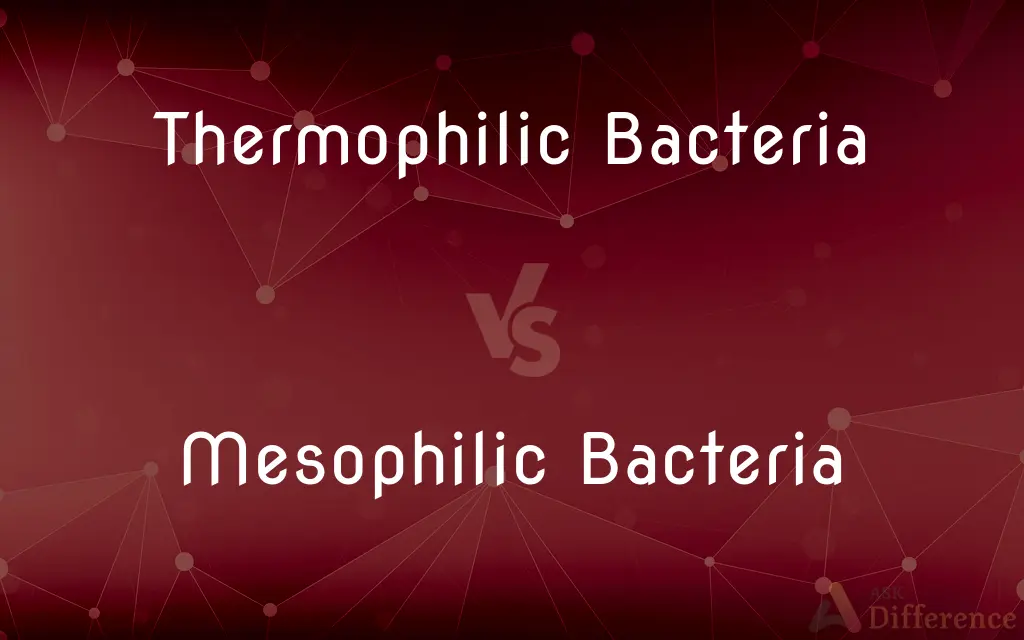Thermophilic Bacteria vs. Mesophilic Bacteria — What's the Difference?
Edited by Tayyaba Rehman — By Fiza Rafique — Published on December 2, 2023
Thermophilic Bacteria thrive in high temperatures, while Mesophilic Bacteria prefer moderate temperatures.

Difference Between Thermophilic Bacteria and Mesophilic Bacteria
Table of Contents
ADVERTISEMENT
Key Differences
Thermophilic Bacteria are organisms that flourish at relatively high temperatures, typically above 45°C, whereas Mesophilic Bacteria are adapted to moderate temperatures, usually between 20°C to 45°C.
In environments like hot springs, Thermophilic Bacteria are dominant, but Mesophilic Bacteria are commonly found in environments close to ambient temperatures, such as in soil or the human body.
Due to their love for heat, Thermophilic Bacteria have proteins and cellular mechanisms adapted to retain stability at high temperatures; conversely, Mesophilic Bacteria have structures optimized for milder climates.
Industrial processes often exploit Thermophilic Bacteria for their ability to act in hot conditions without denaturing. In contrast, many of the Mesophilic Bacteria are essential for processes at moderate temperatures, like yogurt fermentation.
In the context of decomposition, both play vital roles; Thermophilic Bacteria take over during the hotter, later stages of composting, while Mesophilic Bacteria dominate the initial, cooler phase.
ADVERTISEMENT
Comparison Chart
Optimal Temperature
Above 45°C
20°C to 45°C
Typical Habitats
Hot springs, geothermal areas
Soil, human body, ambient environments
Cellular Adaptations
Stable proteins at high temperatures
Proteins optimized for moderate temperatures
Industrial Uses
Processes requiring high temperatures
Processes at ambient or moderate temperatures
Role in Decomposition
Active during hotter stages of composting
Dominate initial, cooler phases of composting
Compare with Definitions
Thermophilic Bacteria
Heat-preferring microorganisms.
Studies of Thermophilic Bacteria help understand life in extreme environments.
Mesophilic Bacteria
Bacteria preferring moderate temperatures.
Soil is abundant in Mesophilic Bacteria due to its ambient temperature.
Thermophilic Bacteria
Bacteria adapted to high heat.
Certain industrial processes harness the heat resistance of Thermophilic Bacteria.
Mesophilic Bacteria
Thrive at room temperatures.
Storing food at lower temperatures inhibits the growth of many Mesophilic Bacteria.
Thermophilic Bacteria
Lovers of elevated temperatures.
The boiling mud pots in geothermal regions are homes to Thermophilic Bacteria.
Mesophilic Bacteria
Organisms flourishing between 20°C to 45°C.
Yogurt production relies on Mesophilic Bacteria for fermentation.
Thermophilic Bacteria
Microorganisms thriving above 45°C.
Hot springs are teeming with Thermophilic Bacteria.
Mesophilic Bacteria
Lovers of mild warmth.
The human gut is a habitat for several Mesophilic Bacteria aiding digestion.
Thermophilic Bacteria
Stable in hot conditions.
In composting, Thermophilic Bacteria break down materials during the high-heat phase.
Mesophilic Bacteria
Ambient-temperature microorganisms.
Many common bacteria in everyday environments are Mesophilic Bacteria.
Common Curiosities
Are Thermophilic Bacteria found in hot springs?
Yes, hot springs are abundant in Thermophilic Bacteria due to the high temperatures.
Why are Thermophilic Bacteria important in composting?
They break down materials during the high-temperature phases of composting.
Where are Mesophilic Bacteria most commonly found?
They're prevalent in environments with moderate temperatures, like soil and the human body.
How have Thermophilic Bacteria adapted to heat?
They have cellular structures and proteins that remain stable at high temperatures.
Can Mesophilic Bacteria be used in fermentation?
Yes, many fermentation processes, like yogurt making, employ Mesophilic Bacteria.
At what temperature do Thermophilic Bacteria optimally grow?
They thrive at temperatures typically above 45°C.
Are Mesophilic Bacteria harmful to humans?
While many are harmless and even beneficial, some can cause diseases if they enter the body.
What temperature range is detrimental to Mesophilic Bacteria?
Temperatures below 20°C and above 45°C are typically not conducive for their growth.
Share Your Discovery

Previous Comparison
Neurilemma Sheath vs. Myelin Sheath
Next Comparison
Shrimp vs. PrawnsAuthor Spotlight
Written by
Fiza RafiqueFiza Rafique is a skilled content writer at AskDifference.com, where she meticulously refines and enhances written pieces. Drawing from her vast editorial expertise, Fiza ensures clarity, accuracy, and precision in every article. Passionate about language, she continually seeks to elevate the quality of content for readers worldwide.
Edited by
Tayyaba RehmanTayyaba Rehman is a distinguished writer, currently serving as a primary contributor to askdifference.com. As a researcher in semantics and etymology, Tayyaba's passion for the complexity of languages and their distinctions has found a perfect home on the platform. Tayyaba delves into the intricacies of language, distinguishing between commonly confused words and phrases, thereby providing clarity for readers worldwide.
















































